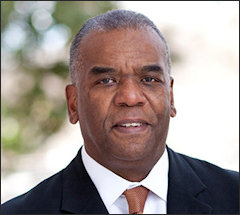
Marcus Martin
Two days ago, I posted an article, “How Big Is UVa’s Diversity Bureaucracy?” In it, I noted that Marcus Martin, the University of Virginia’s chief diversity officer, was paid $349,000, the highest salary of any of 50 higher-education diversity officer identified by Campus Reform. I also endeavored to describe the size and effectiveness of UVa’s diversity bureaucracy.
In response, I received this communication from UVa spokesman Anthony de Bruyn, which I reproduce in full:
I write to provide you and your readers important context and clarifications regarding your article “How Big Is UVa’s Diversity Bureaucracy?”
Marcus Martin, M.D., is a practicing physician, professor of emergency medicine and the founding chair of the School of Medicine’s Emergency Department, as well as vice president and chief diversity and inclusion officer at the University of Virginia. Through his clinical activities, educating and mentoring of medical students and young physicians, he contributes to our medical and education missions. He also teaches a popular course for undergraduates. Dr. Martin is a well-published author and has served in several prominent emergency medicine leadership roles across the nation. And, he is involved in several community-based organizations in Charlottesville and Albemarle County. His compensation reflects not only his responsibilities as the University’s chief diversity officer, but also his role as a medical doctor and long-time faculty member. The characterization of him as merely a bureaucrat is pretty far off the mark.
Just last month, the National Science Foundation again awarded a $5 million grant for which Dr. Martin has been the principal investigator. This grant, in its second renewal, seeks to boost the number of underrepresented minority students in STEM careers. The grant involves a consortium of eight universities and colleges, the Virginia-North Carolina Alliance, in addition to the University of Virginia. NSF renewed the grant because of its demonstrated outcomes.
Your article unfairly criticizes the work of several committees at the University that make important contributions to our living and learning environment, and implies a large number of full-time bureaucrats who do little else. The members of these committees are students, faculty, staff and community representatives who volunteer their time and expertise over and above their academic and work commitments. The committees study important issues such as improving our recruitment and retention of faculty, staff and students from historically underrepresented groups, and enhancing our community of inclusiveness and to make UVA a better place for everyone.
And, despite the suggestion that there are few substantive results from our diversity efforts, the University has the highest graduation rate for African American students of any public university in the nation. Our current focus is helping minority students succeed in the STEM fields. Next month we will welcome the most diverse class in UVA’s history.
The Board of Visitors recently approved an endowed professorship in Dr. Martin’s name in recognition of his valuable and lasting contributions to medical education and the University community.
Bacon’s response: Dr. Martin sounds like major asset to the university. (See his full bio here. It is impressive.) I don’t think my article characterized him as “merely a bureaucrat,” but if I left that impression, I am happy to stand corrected.
Now, on the much more substantive issue of the effectiveness of UVa’s diversity program, one of de Bruyn’s statements — “the University has the highest graduation rate for African American students of any public university in the nation” — also could use some context.
Yes, it’s true, UVa does have the highest graduation rate for African-American students of any public university in the nation. That’s an achievement for which the university deserves accolades, and which I have lauded on more than one occasion.
However, UVa also has one of the strictest admissions policies of any public university in the country — certainly of any public university in the state — as seen in the exceptionally low percentage of lower-income Pell grant students in the student body. There is a very high correlation between Pell grant status and the six-year drop-out rate. More Pell students means more drop-outs; fewer Pell students means higher graduation rates. Insofar as Pell grant recipients disproportionately hail from African-American families, UVa’s admissions policies limit the number of lower-income African-Americans at higher risk of dropping out.
So, the question is this: Is the exceptionally high graduation rate of UVa’s African-American students due to the ministrations of the diversity bureaucracy or to the stringency of the university’s admissions policies, to some combination of the two, or perhaps to other policies entirely? I would love to see some hard data.


